Assignment 3 Health Planning Essay 2022
VerifiedAdded on 2022/09/27
|12
|3316
|23
Assignment
AI Summary
Contribute Materials
Your contribution can guide someone’s learning journey. Share your
documents today.
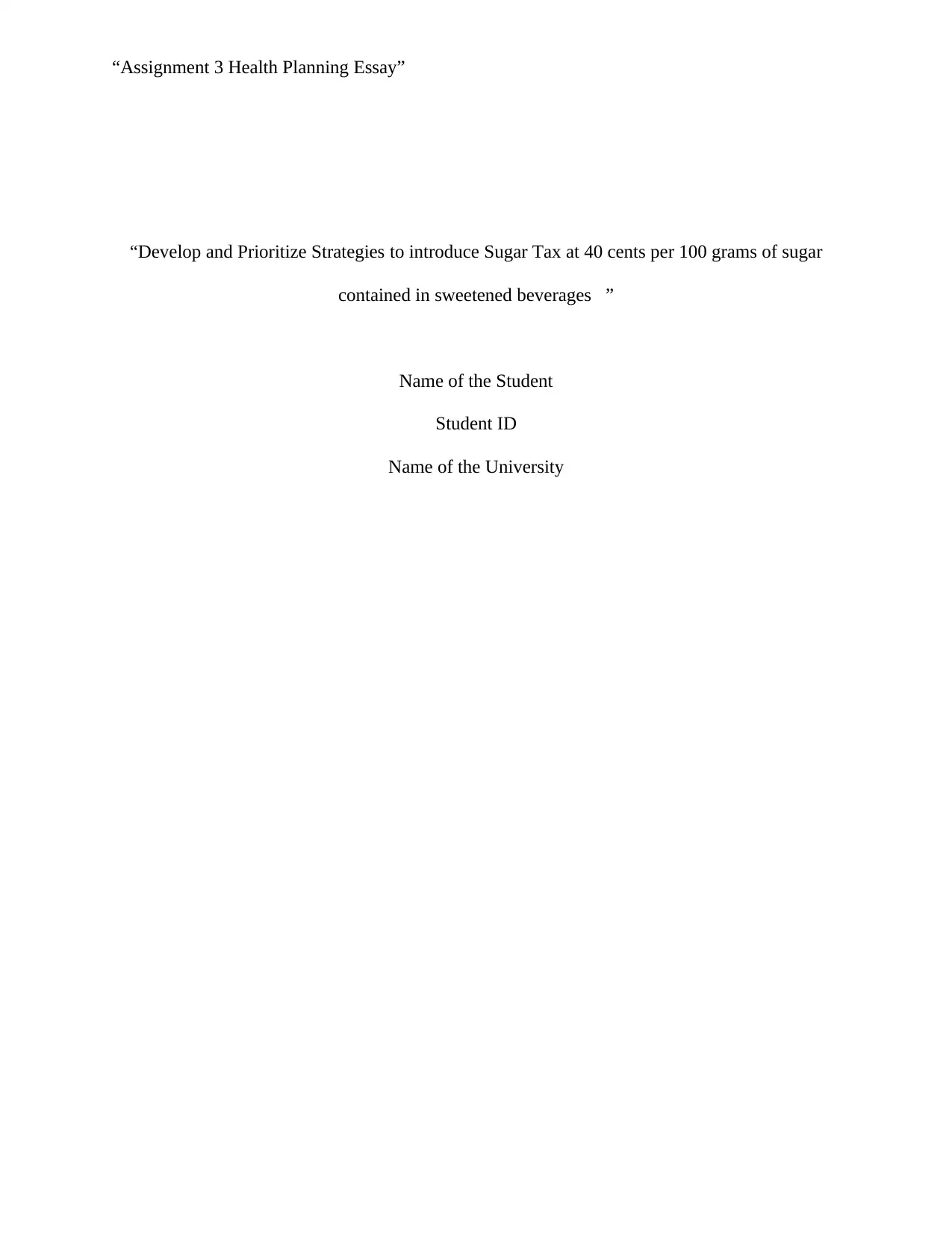
“Assignment 3 Health Planning Essay”
“Develop and Prioritize Strategies to introduce Sugar Tax at 40 cents per 100 grams of sugar
contained in sweetened beverages ”
Name of the Student
Student ID
Name of the University
“Develop and Prioritize Strategies to introduce Sugar Tax at 40 cents per 100 grams of sugar
contained in sweetened beverages ”
Name of the Student
Student ID
Name of the University
Secure Best Marks with AI Grader
Need help grading? Try our AI Grader for instant feedback on your assignments.
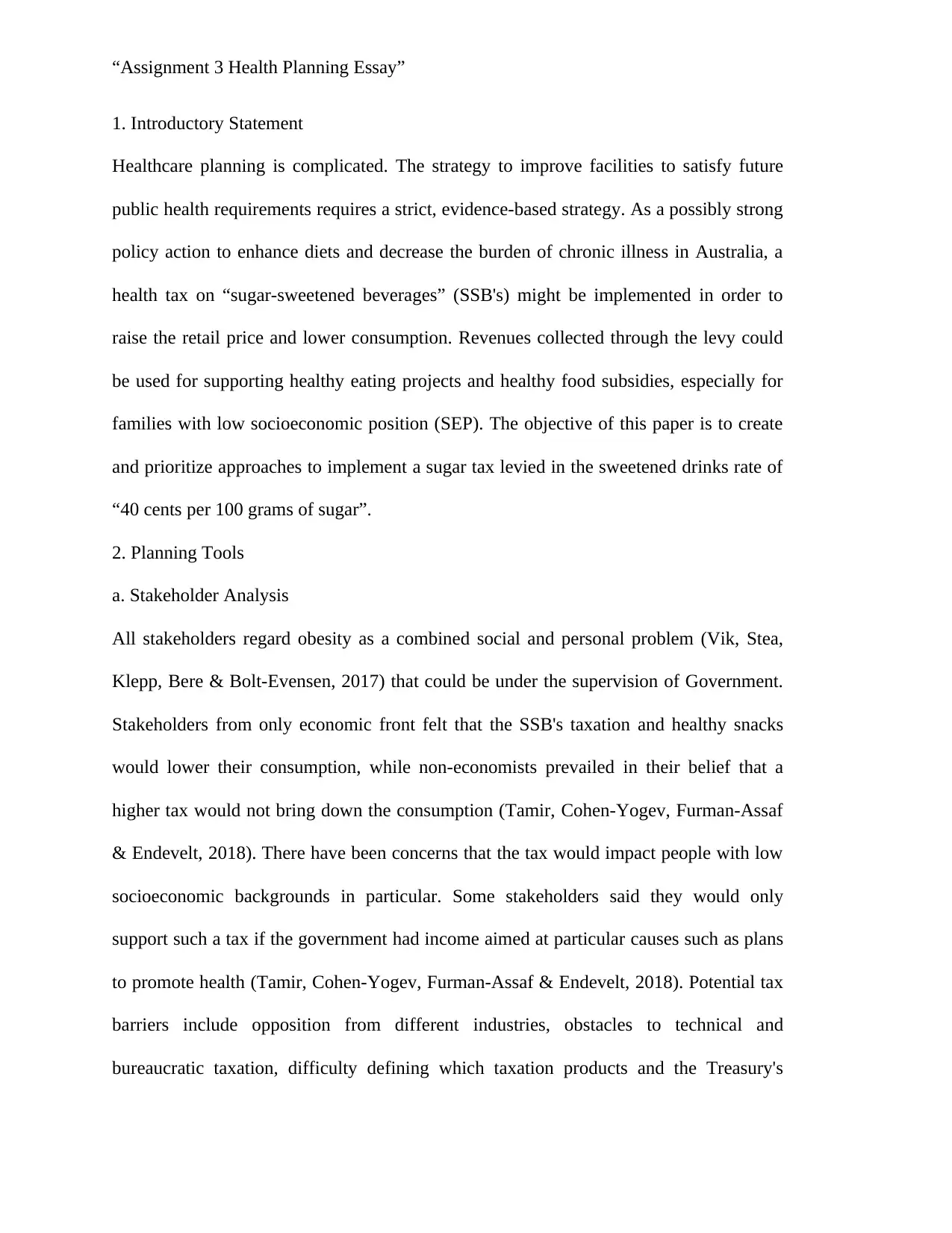
“Assignment 3 Health Planning Essay”
1. Introductory Statement
Healthcare planning is complicated. The strategy to improve facilities to satisfy future
public health requirements requires a strict, evidence-based strategy. As a possibly strong
policy action to enhance diets and decrease the burden of chronic illness in Australia, a
health tax on “sugar-sweetened beverages” (SSB's) might be implemented in order to
raise the retail price and lower consumption. Revenues collected through the levy could
be used for supporting healthy eating projects and healthy food subsidies, especially for
families with low socioeconomic position (SEP). The objective of this paper is to create
and prioritize approaches to implement a sugar tax levied in the sweetened drinks rate of
“40 cents per 100 grams of sugar”.
2. Planning Tools
a. Stakeholder Analysis
All stakeholders regard obesity as a combined social and personal problem (Vik, Stea,
Klepp, Bere & Bolt-Evensen, 2017) that could be under the supervision of Government.
Stakeholders from only economic front felt that the SSB's taxation and healthy snacks
would lower their consumption, while non-economists prevailed in their belief that a
higher tax would not bring down the consumption (Tamir, Cohen-Yogev, Furman-Assaf
& Endevelt, 2018). There have been concerns that the tax would impact people with low
socioeconomic backgrounds in particular. Some stakeholders said they would only
support such a tax if the government had income aimed at particular causes such as plans
to promote health (Tamir, Cohen-Yogev, Furman-Assaf & Endevelt, 2018). Potential tax
barriers include opposition from different industries, obstacles to technical and
bureaucratic taxation, difficulty defining which taxation products and the Treasury's
1. Introductory Statement
Healthcare planning is complicated. The strategy to improve facilities to satisfy future
public health requirements requires a strict, evidence-based strategy. As a possibly strong
policy action to enhance diets and decrease the burden of chronic illness in Australia, a
health tax on “sugar-sweetened beverages” (SSB's) might be implemented in order to
raise the retail price and lower consumption. Revenues collected through the levy could
be used for supporting healthy eating projects and healthy food subsidies, especially for
families with low socioeconomic position (SEP). The objective of this paper is to create
and prioritize approaches to implement a sugar tax levied in the sweetened drinks rate of
“40 cents per 100 grams of sugar”.
2. Planning Tools
a. Stakeholder Analysis
All stakeholders regard obesity as a combined social and personal problem (Vik, Stea,
Klepp, Bere & Bolt-Evensen, 2017) that could be under the supervision of Government.
Stakeholders from only economic front felt that the SSB's taxation and healthy snacks
would lower their consumption, while non-economists prevailed in their belief that a
higher tax would not bring down the consumption (Tamir, Cohen-Yogev, Furman-Assaf
& Endevelt, 2018). There have been concerns that the tax would impact people with low
socioeconomic backgrounds in particular. Some stakeholders said they would only
support such a tax if the government had income aimed at particular causes such as plans
to promote health (Tamir, Cohen-Yogev, Furman-Assaf & Endevelt, 2018). Potential tax
barriers include opposition from different industries, obstacles to technical and
bureaucratic taxation, difficulty defining which taxation products and the Treasury's
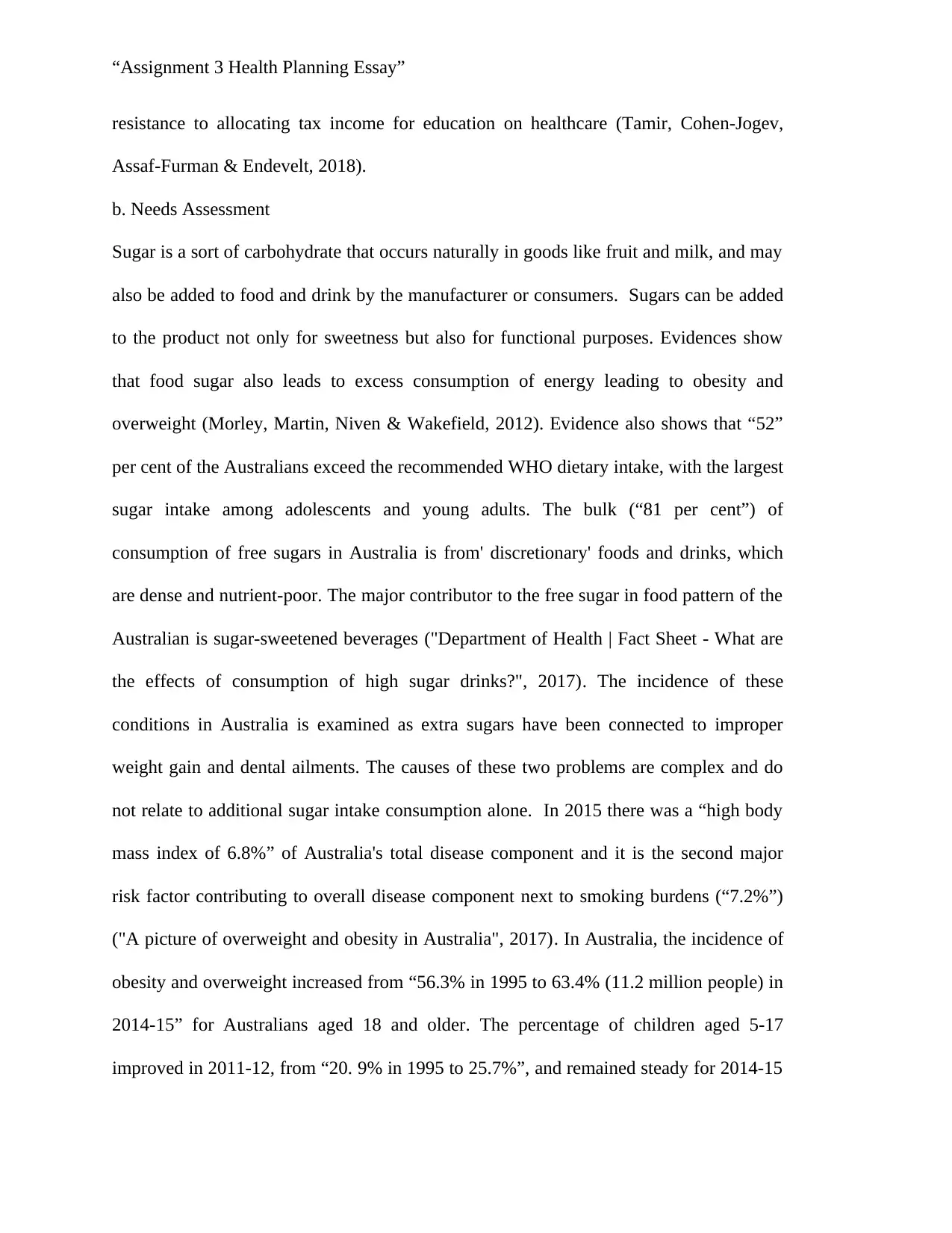
“Assignment 3 Health Planning Essay”
resistance to allocating tax income for education on healthcare (Tamir, Cohen-Jogev,
Assaf-Furman & Endevelt, 2018).
b. Needs Assessment
Sugar is a sort of carbohydrate that occurs naturally in goods like fruit and milk, and may
also be added to food and drink by the manufacturer or consumers. Sugars can be added
to the product not only for sweetness but also for functional purposes. Evidences show
that food sugar also leads to excess consumption of energy leading to obesity and
overweight (Morley, Martin, Niven & Wakefield, 2012). Evidence also shows that “52”
per cent of the Australians exceed the recommended WHO dietary intake, with the largest
sugar intake among adolescents and young adults. The bulk (“81 per cent”) of
consumption of free sugars in Australia is from' discretionary' foods and drinks, which
are dense and nutrient-poor. The major contributor to the free sugar in food pattern of the
Australian is sugar-sweetened beverages ("Department of Health | Fact Sheet - What are
the effects of consumption of high sugar drinks?", 2017). The incidence of these
conditions in Australia is examined as extra sugars have been connected to improper
weight gain and dental ailments. The causes of these two problems are complex and do
not relate to additional sugar intake consumption alone. In 2015 there was a “high body
mass index of 6.8%” of Australia's total disease component and it is the second major
risk factor contributing to overall disease component next to smoking burdens (“7.2%”)
("A picture of overweight and obesity in Australia", 2017). In Australia, the incidence of
obesity and overweight increased from “56.3% in 1995 to 63.4% (11.2 million people) in
2014-15” for Australians aged 18 and older. The percentage of children aged 5-17
improved in 2011-12, from “20. 9% in 1995 to 25.7%”, and remained steady for 2014-15
resistance to allocating tax income for education on healthcare (Tamir, Cohen-Jogev,
Assaf-Furman & Endevelt, 2018).
b. Needs Assessment
Sugar is a sort of carbohydrate that occurs naturally in goods like fruit and milk, and may
also be added to food and drink by the manufacturer or consumers. Sugars can be added
to the product not only for sweetness but also for functional purposes. Evidences show
that food sugar also leads to excess consumption of energy leading to obesity and
overweight (Morley, Martin, Niven & Wakefield, 2012). Evidence also shows that “52”
per cent of the Australians exceed the recommended WHO dietary intake, with the largest
sugar intake among adolescents and young adults. The bulk (“81 per cent”) of
consumption of free sugars in Australia is from' discretionary' foods and drinks, which
are dense and nutrient-poor. The major contributor to the free sugar in food pattern of the
Australian is sugar-sweetened beverages ("Department of Health | Fact Sheet - What are
the effects of consumption of high sugar drinks?", 2017). The incidence of these
conditions in Australia is examined as extra sugars have been connected to improper
weight gain and dental ailments. The causes of these two problems are complex and do
not relate to additional sugar intake consumption alone. In 2015 there was a “high body
mass index of 6.8%” of Australia's total disease component and it is the second major
risk factor contributing to overall disease component next to smoking burdens (“7.2%”)
("A picture of overweight and obesity in Australia", 2017). In Australia, the incidence of
obesity and overweight increased from “56.3% in 1995 to 63.4% (11.2 million people) in
2014-15” for Australians aged 18 and older. The percentage of children aged 5-17
improved in 2011-12, from “20. 9% in 1995 to 25.7%”, and remained steady for 2014-15
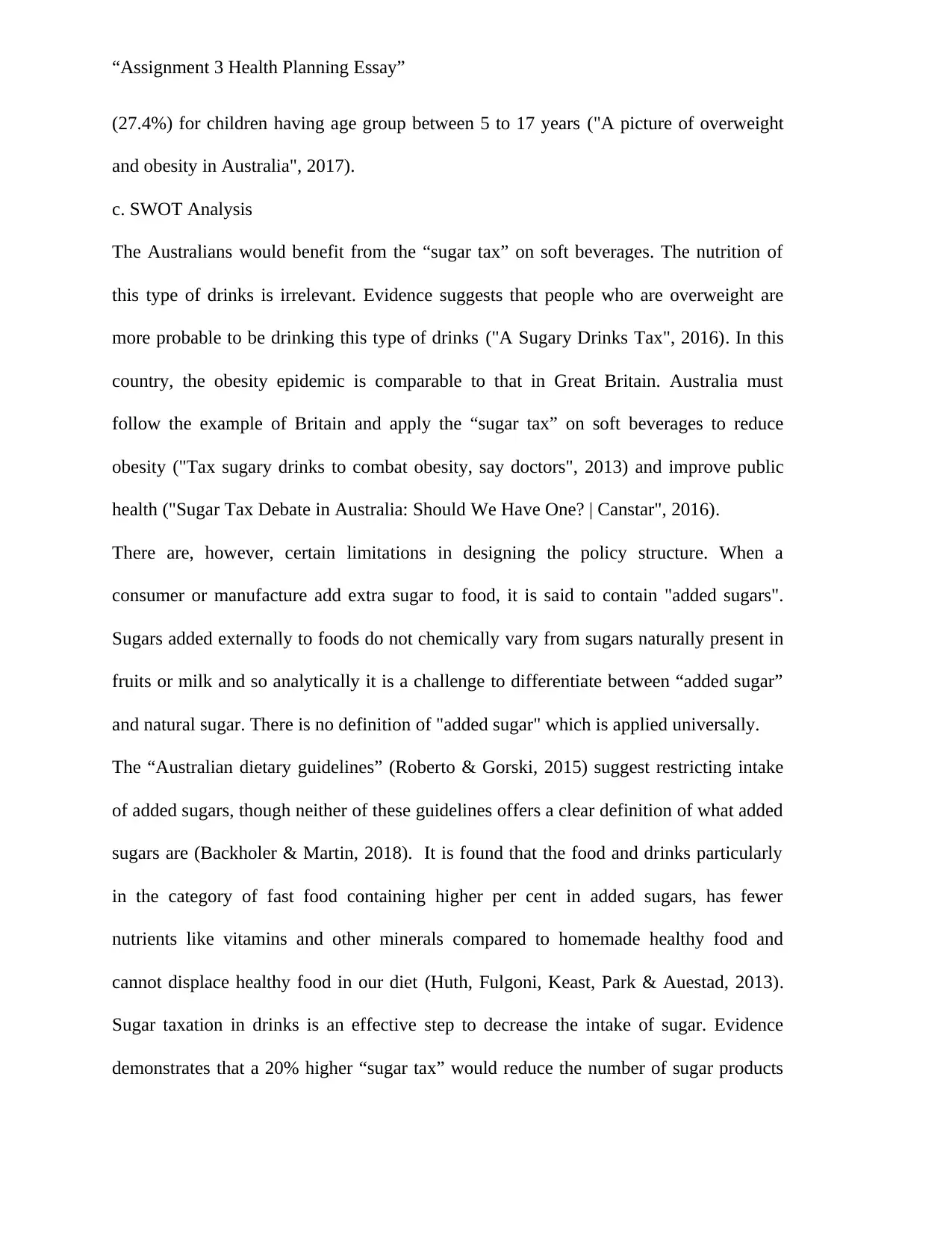
“Assignment 3 Health Planning Essay”
(27.4%) for children having age group between 5 to 17 years ("A picture of overweight
and obesity in Australia", 2017).
c. SWOT Analysis
The Australians would benefit from the “sugar tax” on soft beverages. The nutrition of
this type of drinks is irrelevant. Evidence suggests that people who are overweight are
more probable to be drinking this type of drinks ("A Sugary Drinks Tax", 2016). In this
country, the obesity epidemic is comparable to that in Great Britain. Australia must
follow the example of Britain and apply the “sugar tax” on soft beverages to reduce
obesity ("Tax sugary drinks to combat obesity, say doctors", 2013) and improve public
health ("Sugar Tax Debate in Australia: Should We Have One? | Canstar", 2016).
There are, however, certain limitations in designing the policy structure. When a
consumer or manufacture add extra sugar to food, it is said to contain "added sugars".
Sugars added externally to foods do not chemically vary from sugars naturally present in
fruits or milk and so analytically it is a challenge to differentiate between “added sugar”
and natural sugar. There is no definition of "added sugar" which is applied universally.
The “Australian dietary guidelines” (Roberto & Gorski, 2015) suggest restricting intake
of added sugars, though neither of these guidelines offers a clear definition of what added
sugars are (Backholer & Martin, 2018). It is found that the food and drinks particularly
in the category of fast food containing higher per cent in added sugars, has fewer
nutrients like vitamins and other minerals compared to homemade healthy food and
cannot displace healthy food in our diet (Huth, Fulgoni, Keast, Park & Auestad, 2013).
Sugar taxation in drinks is an effective step to decrease the intake of sugar. Evidence
demonstrates that a 20% higher “sugar tax” would reduce the number of sugar products
(27.4%) for children having age group between 5 to 17 years ("A picture of overweight
and obesity in Australia", 2017).
c. SWOT Analysis
The Australians would benefit from the “sugar tax” on soft beverages. The nutrition of
this type of drinks is irrelevant. Evidence suggests that people who are overweight are
more probable to be drinking this type of drinks ("A Sugary Drinks Tax", 2016). In this
country, the obesity epidemic is comparable to that in Great Britain. Australia must
follow the example of Britain and apply the “sugar tax” on soft beverages to reduce
obesity ("Tax sugary drinks to combat obesity, say doctors", 2013) and improve public
health ("Sugar Tax Debate in Australia: Should We Have One? | Canstar", 2016).
There are, however, certain limitations in designing the policy structure. When a
consumer or manufacture add extra sugar to food, it is said to contain "added sugars".
Sugars added externally to foods do not chemically vary from sugars naturally present in
fruits or milk and so analytically it is a challenge to differentiate between “added sugar”
and natural sugar. There is no definition of "added sugar" which is applied universally.
The “Australian dietary guidelines” (Roberto & Gorski, 2015) suggest restricting intake
of added sugars, though neither of these guidelines offers a clear definition of what added
sugars are (Backholer & Martin, 2018). It is found that the food and drinks particularly
in the category of fast food containing higher per cent in added sugars, has fewer
nutrients like vitamins and other minerals compared to homemade healthy food and
cannot displace healthy food in our diet (Huth, Fulgoni, Keast, Park & Auestad, 2013).
Sugar taxation in drinks is an effective step to decrease the intake of sugar. Evidence
demonstrates that a 20% higher “sugar tax” would reduce the number of sugar products
Secure Best Marks with AI Grader
Need help grading? Try our AI Grader for instant feedback on your assignments.
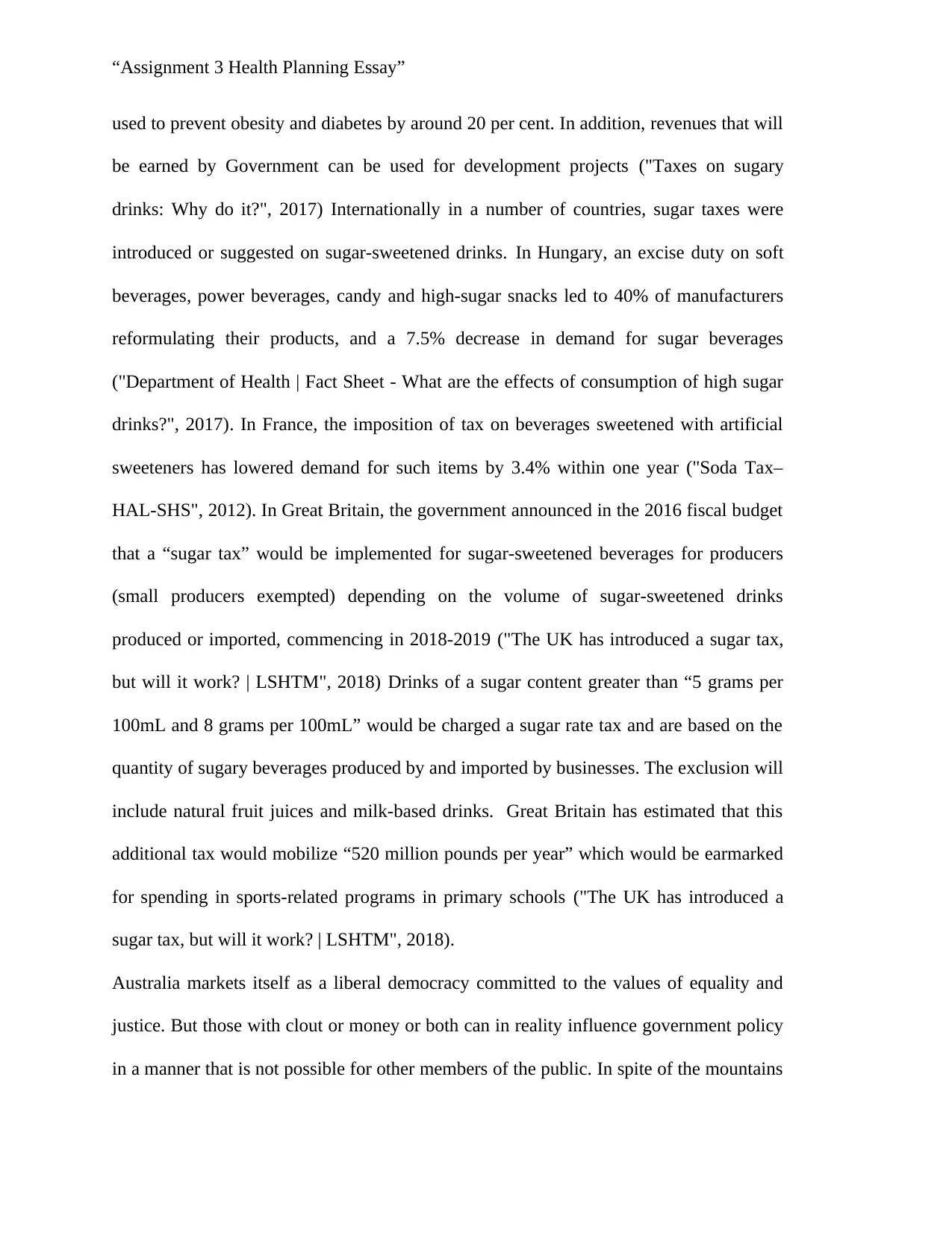
“Assignment 3 Health Planning Essay”
used to prevent obesity and diabetes by around 20 per cent. In addition, revenues that will
be earned by Government can be used for development projects ("Taxes on sugary
drinks: Why do it?", 2017) Internationally in a number of countries, sugar taxes were
introduced or suggested on sugar-sweetened drinks. In Hungary, an excise duty on soft
beverages, power beverages, candy and high-sugar snacks led to 40% of manufacturers
reformulating their products, and a 7.5% decrease in demand for sugar beverages
("Department of Health | Fact Sheet - What are the effects of consumption of high sugar
drinks?", 2017). In France, the imposition of tax on beverages sweetened with artificial
sweeteners has lowered demand for such items by 3.4% within one year ("Soda Tax–
HAL-SHS", 2012). In Great Britain, the government announced in the 2016 fiscal budget
that a “sugar tax” would be implemented for sugar-sweetened beverages for producers
(small producers exempted) depending on the volume of sugar-sweetened drinks
produced or imported, commencing in 2018-2019 ("The UK has introduced a sugar tax,
but will it work? | LSHTM", 2018) Drinks of a sugar content greater than “5 grams per
100mL and 8 grams per 100mL” would be charged a sugar rate tax and are based on the
quantity of sugary beverages produced by and imported by businesses. The exclusion will
include natural fruit juices and milk-based drinks. Great Britain has estimated that this
additional tax would mobilize “520 million pounds per year” which would be earmarked
for spending in sports-related programs in primary schools ("The UK has introduced a
sugar tax, but will it work? | LSHTM", 2018).
Australia markets itself as a liberal democracy committed to the values of equality and
justice. But those with clout or money or both can in reality influence government policy
in a manner that is not possible for other members of the public. In spite of the mountains
used to prevent obesity and diabetes by around 20 per cent. In addition, revenues that will
be earned by Government can be used for development projects ("Taxes on sugary
drinks: Why do it?", 2017) Internationally in a number of countries, sugar taxes were
introduced or suggested on sugar-sweetened drinks. In Hungary, an excise duty on soft
beverages, power beverages, candy and high-sugar snacks led to 40% of manufacturers
reformulating their products, and a 7.5% decrease in demand for sugar beverages
("Department of Health | Fact Sheet - What are the effects of consumption of high sugar
drinks?", 2017). In France, the imposition of tax on beverages sweetened with artificial
sweeteners has lowered demand for such items by 3.4% within one year ("Soda Tax–
HAL-SHS", 2012). In Great Britain, the government announced in the 2016 fiscal budget
that a “sugar tax” would be implemented for sugar-sweetened beverages for producers
(small producers exempted) depending on the volume of sugar-sweetened drinks
produced or imported, commencing in 2018-2019 ("The UK has introduced a sugar tax,
but will it work? | LSHTM", 2018) Drinks of a sugar content greater than “5 grams per
100mL and 8 grams per 100mL” would be charged a sugar rate tax and are based on the
quantity of sugary beverages produced by and imported by businesses. The exclusion will
include natural fruit juices and milk-based drinks. Great Britain has estimated that this
additional tax would mobilize “520 million pounds per year” which would be earmarked
for spending in sports-related programs in primary schools ("The UK has introduced a
sugar tax, but will it work? | LSHTM", 2018).
Australia markets itself as a liberal democracy committed to the values of equality and
justice. But those with clout or money or both can in reality influence government policy
in a manner that is not possible for other members of the public. In spite of the mountains
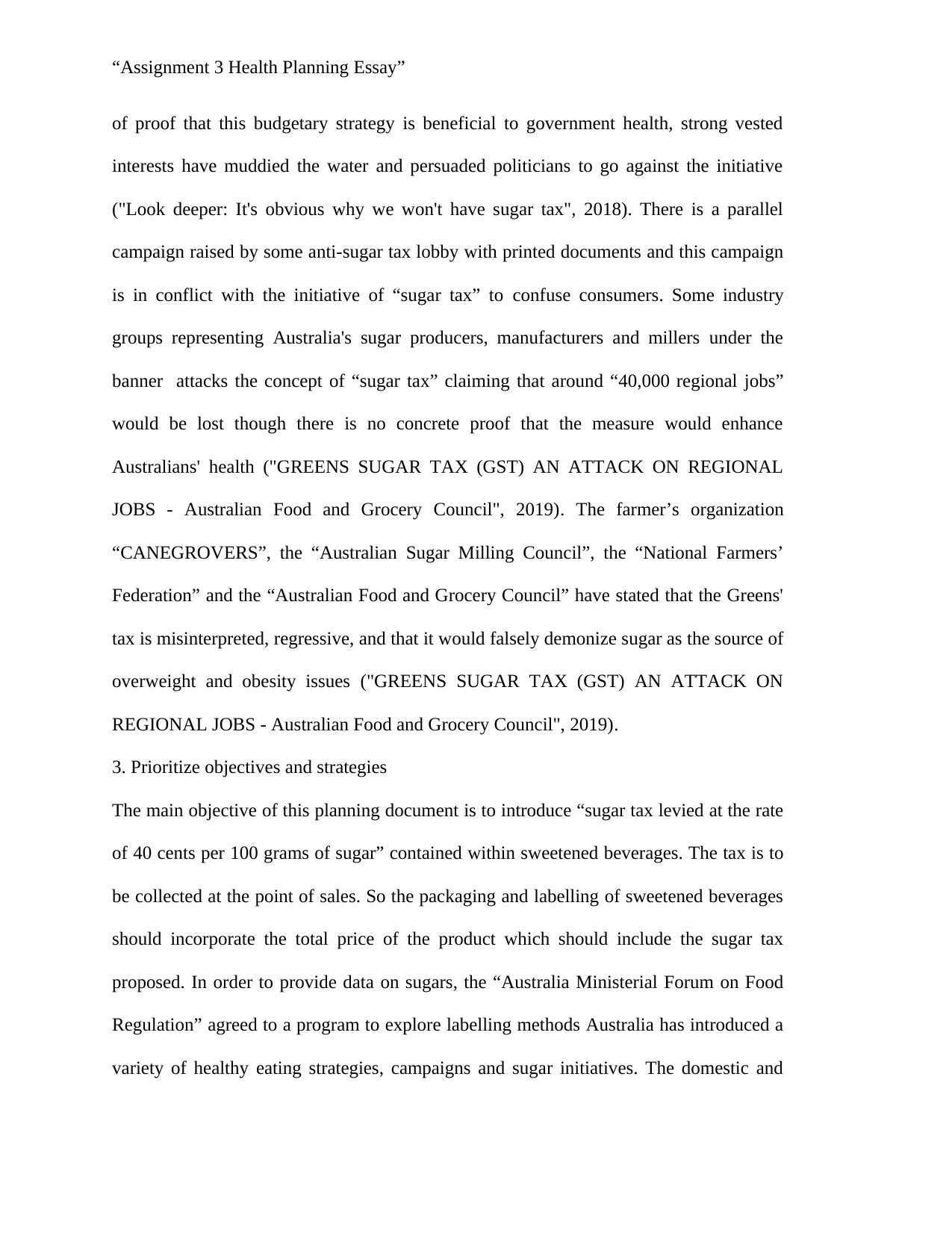
“Assignment 3 Health Planning Essay”
of proof that this budgetary strategy is beneficial to government health, strong vested
interests have muddied the water and persuaded politicians to go against the initiative
("Look deeper: It's obvious why we won't have sugar tax", 2018). There is a parallel
campaign raised by some anti-sugar tax lobby with printed documents and this campaign
is in conflict with the initiative of “sugar tax” to confuse consumers. Some industry
groups representing Australia's sugar producers, manufacturers and millers under the
banner attacks the concept of “sugar tax” claiming that around “40,000 regional jobs”
would be lost though there is no concrete proof that the measure would enhance
Australians' health ("GREENS SUGAR TAX (GST) AN ATTACK ON REGIONAL
JOBS - Australian Food and Grocery Council", 2019). The farmer’s organization
“CANEGROVERS”, the “Australian Sugar Milling Council”, the “National Farmers’
Federation” and the “Australian Food and Grocery Council” have stated that the Greens'
tax is misinterpreted, regressive, and that it would falsely demonize sugar as the source of
overweight and obesity issues ("GREENS SUGAR TAX (GST) AN ATTACK ON
REGIONAL JOBS - Australian Food and Grocery Council", 2019).
3. Prioritize objectives and strategies
The main objective of this planning document is to introduce “sugar tax levied at the rate
of 40 cents per 100 grams of sugar” contained within sweetened beverages. The tax is to
be collected at the point of sales. So the packaging and labelling of sweetened beverages
should incorporate the total price of the product which should include the sugar tax
proposed. In order to provide data on sugars, the “Australia Ministerial Forum on Food
Regulation” agreed to a program to explore labelling methods Australia has introduced a
variety of healthy eating strategies, campaigns and sugar initiatives. The domestic and
of proof that this budgetary strategy is beneficial to government health, strong vested
interests have muddied the water and persuaded politicians to go against the initiative
("Look deeper: It's obvious why we won't have sugar tax", 2018). There is a parallel
campaign raised by some anti-sugar tax lobby with printed documents and this campaign
is in conflict with the initiative of “sugar tax” to confuse consumers. Some industry
groups representing Australia's sugar producers, manufacturers and millers under the
banner attacks the concept of “sugar tax” claiming that around “40,000 regional jobs”
would be lost though there is no concrete proof that the measure would enhance
Australians' health ("GREENS SUGAR TAX (GST) AN ATTACK ON REGIONAL
JOBS - Australian Food and Grocery Council", 2019). The farmer’s organization
“CANEGROVERS”, the “Australian Sugar Milling Council”, the “National Farmers’
Federation” and the “Australian Food and Grocery Council” have stated that the Greens'
tax is misinterpreted, regressive, and that it would falsely demonize sugar as the source of
overweight and obesity issues ("GREENS SUGAR TAX (GST) AN ATTACK ON
REGIONAL JOBS - Australian Food and Grocery Council", 2019).
3. Prioritize objectives and strategies
The main objective of this planning document is to introduce “sugar tax levied at the rate
of 40 cents per 100 grams of sugar” contained within sweetened beverages. The tax is to
be collected at the point of sales. So the packaging and labelling of sweetened beverages
should incorporate the total price of the product which should include the sugar tax
proposed. In order to provide data on sugars, the “Australia Ministerial Forum on Food
Regulation” agreed to a program to explore labelling methods Australia has introduced a
variety of healthy eating strategies, campaigns and sugar initiatives. The domestic and
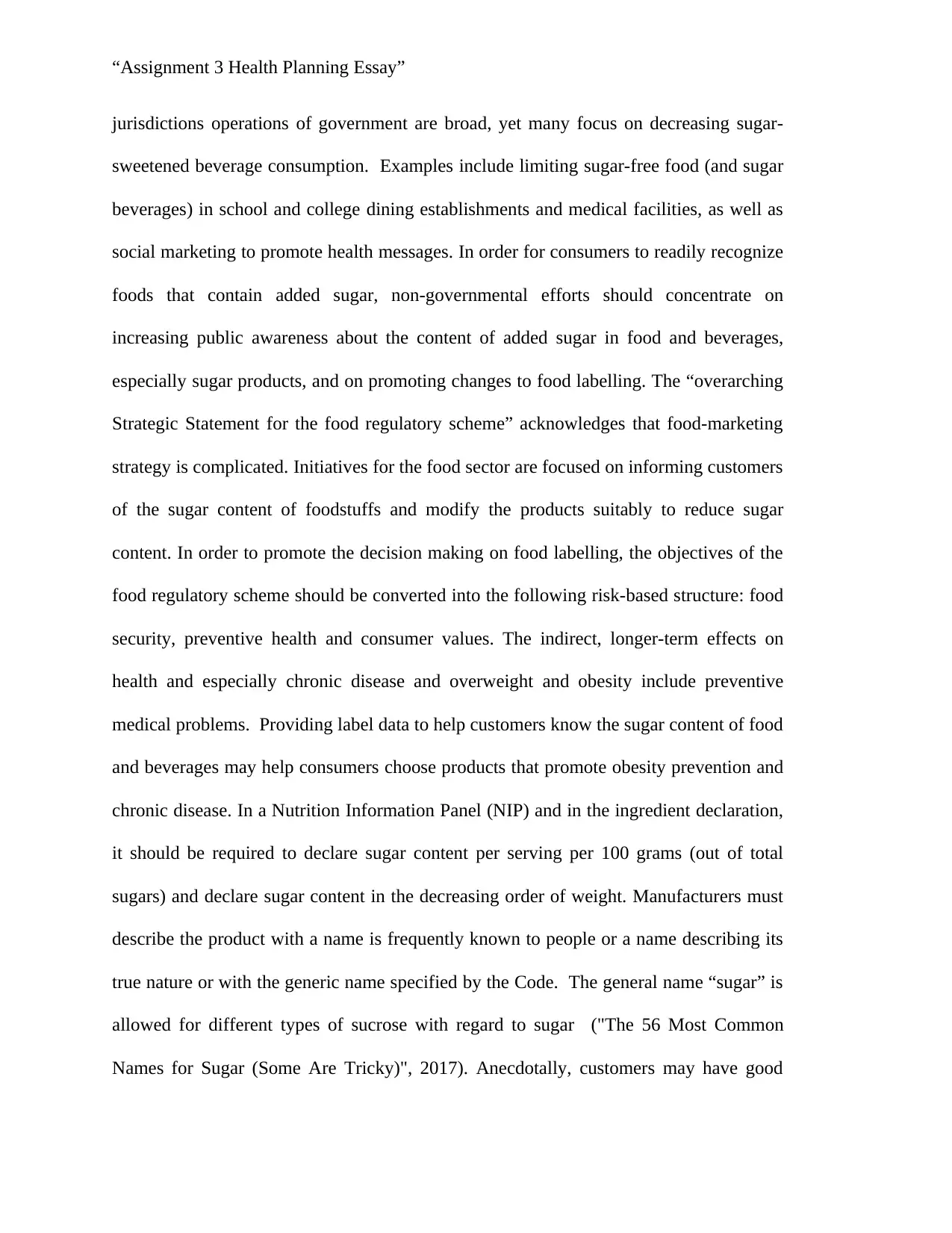
“Assignment 3 Health Planning Essay”
jurisdictions operations of government are broad, yet many focus on decreasing sugar-
sweetened beverage consumption. Examples include limiting sugar-free food (and sugar
beverages) in school and college dining establishments and medical facilities, as well as
social marketing to promote health messages. In order for consumers to readily recognize
foods that contain added sugar, non-governmental efforts should concentrate on
increasing public awareness about the content of added sugar in food and beverages,
especially sugar products, and on promoting changes to food labelling. The “overarching
Strategic Statement for the food regulatory scheme” acknowledges that food-marketing
strategy is complicated. Initiatives for the food sector are focused on informing customers
of the sugar content of foodstuffs and modify the products suitably to reduce sugar
content. In order to promote the decision making on food labelling, the objectives of the
food regulatory scheme should be converted into the following risk-based structure: food
security, preventive health and consumer values. The indirect, longer-term effects on
health and especially chronic disease and overweight and obesity include preventive
medical problems. Providing label data to help customers know the sugar content of food
and beverages may help consumers choose products that promote obesity prevention and
chronic disease. In a Nutrition Information Panel (NIP) and in the ingredient declaration,
it should be required to declare sugar content per serving per 100 grams (out of total
sugars) and declare sugar content in the decreasing order of weight. Manufacturers must
describe the product with a name is frequently known to people or a name describing its
true nature or with the generic name specified by the Code. The general name “sugar” is
allowed for different types of sucrose with regard to sugar ("The 56 Most Common
Names for Sugar (Some Are Tricky)", 2017). Anecdotally, customers may have good
jurisdictions operations of government are broad, yet many focus on decreasing sugar-
sweetened beverage consumption. Examples include limiting sugar-free food (and sugar
beverages) in school and college dining establishments and medical facilities, as well as
social marketing to promote health messages. In order for consumers to readily recognize
foods that contain added sugar, non-governmental efforts should concentrate on
increasing public awareness about the content of added sugar in food and beverages,
especially sugar products, and on promoting changes to food labelling. The “overarching
Strategic Statement for the food regulatory scheme” acknowledges that food-marketing
strategy is complicated. Initiatives for the food sector are focused on informing customers
of the sugar content of foodstuffs and modify the products suitably to reduce sugar
content. In order to promote the decision making on food labelling, the objectives of the
food regulatory scheme should be converted into the following risk-based structure: food
security, preventive health and consumer values. The indirect, longer-term effects on
health and especially chronic disease and overweight and obesity include preventive
medical problems. Providing label data to help customers know the sugar content of food
and beverages may help consumers choose products that promote obesity prevention and
chronic disease. In a Nutrition Information Panel (NIP) and in the ingredient declaration,
it should be required to declare sugar content per serving per 100 grams (out of total
sugars) and declare sugar content in the decreasing order of weight. Manufacturers must
describe the product with a name is frequently known to people or a name describing its
true nature or with the generic name specified by the Code. The general name “sugar” is
allowed for different types of sucrose with regard to sugar ("The 56 Most Common
Names for Sugar (Some Are Tricky)", 2017). Anecdotally, customers may have good
Paraphrase This Document
Need a fresh take? Get an instant paraphrase of this document with our AI Paraphraser
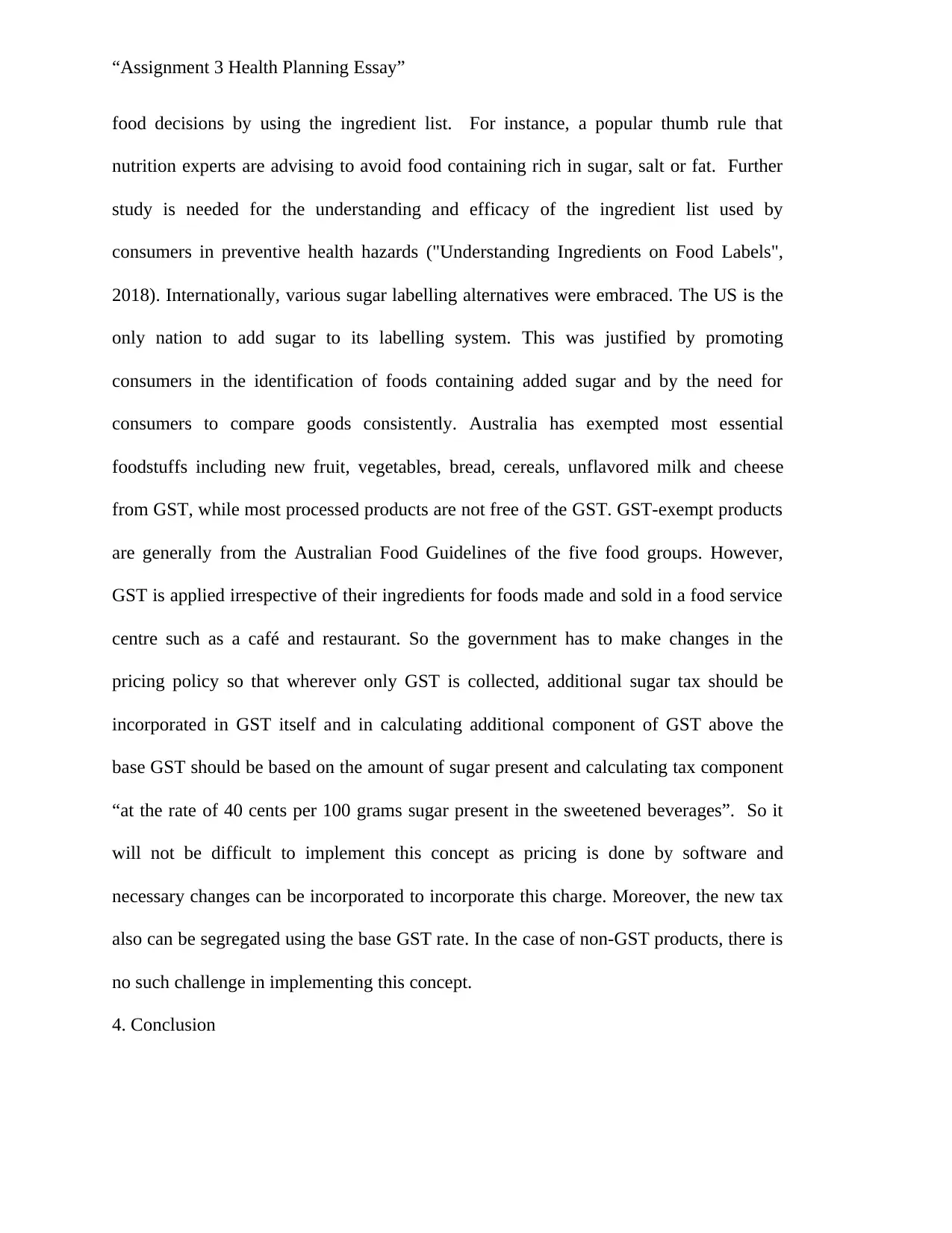
“Assignment 3 Health Planning Essay”
food decisions by using the ingredient list. For instance, a popular thumb rule that
nutrition experts are advising to avoid food containing rich in sugar, salt or fat. Further
study is needed for the understanding and efficacy of the ingredient list used by
consumers in preventive health hazards ("Understanding Ingredients on Food Labels",
2018). Internationally, various sugar labelling alternatives were embraced. The US is the
only nation to add sugar to its labelling system. This was justified by promoting
consumers in the identification of foods containing added sugar and by the need for
consumers to compare goods consistently. Australia has exempted most essential
foodstuffs including new fruit, vegetables, bread, cereals, unflavored milk and cheese
from GST, while most processed products are not free of the GST. GST-exempt products
are generally from the Australian Food Guidelines of the five food groups. However,
GST is applied irrespective of their ingredients for foods made and sold in a food service
centre such as a café and restaurant. So the government has to make changes in the
pricing policy so that wherever only GST is collected, additional sugar tax should be
incorporated in GST itself and in calculating additional component of GST above the
base GST should be based on the amount of sugar present and calculating tax component
“at the rate of 40 cents per 100 grams sugar present in the sweetened beverages”. So it
will not be difficult to implement this concept as pricing is done by software and
necessary changes can be incorporated to incorporate this charge. Moreover, the new tax
also can be segregated using the base GST rate. In the case of non-GST products, there is
no such challenge in implementing this concept.
4. Conclusion
food decisions by using the ingredient list. For instance, a popular thumb rule that
nutrition experts are advising to avoid food containing rich in sugar, salt or fat. Further
study is needed for the understanding and efficacy of the ingredient list used by
consumers in preventive health hazards ("Understanding Ingredients on Food Labels",
2018). Internationally, various sugar labelling alternatives were embraced. The US is the
only nation to add sugar to its labelling system. This was justified by promoting
consumers in the identification of foods containing added sugar and by the need for
consumers to compare goods consistently. Australia has exempted most essential
foodstuffs including new fruit, vegetables, bread, cereals, unflavored milk and cheese
from GST, while most processed products are not free of the GST. GST-exempt products
are generally from the Australian Food Guidelines of the five food groups. However,
GST is applied irrespective of their ingredients for foods made and sold in a food service
centre such as a café and restaurant. So the government has to make changes in the
pricing policy so that wherever only GST is collected, additional sugar tax should be
incorporated in GST itself and in calculating additional component of GST above the
base GST should be based on the amount of sugar present and calculating tax component
“at the rate of 40 cents per 100 grams sugar present in the sweetened beverages”. So it
will not be difficult to implement this concept as pricing is done by software and
necessary changes can be incorporated to incorporate this charge. Moreover, the new tax
also can be segregated using the base GST rate. In the case of non-GST products, there is
no such challenge in implementing this concept.
4. Conclusion
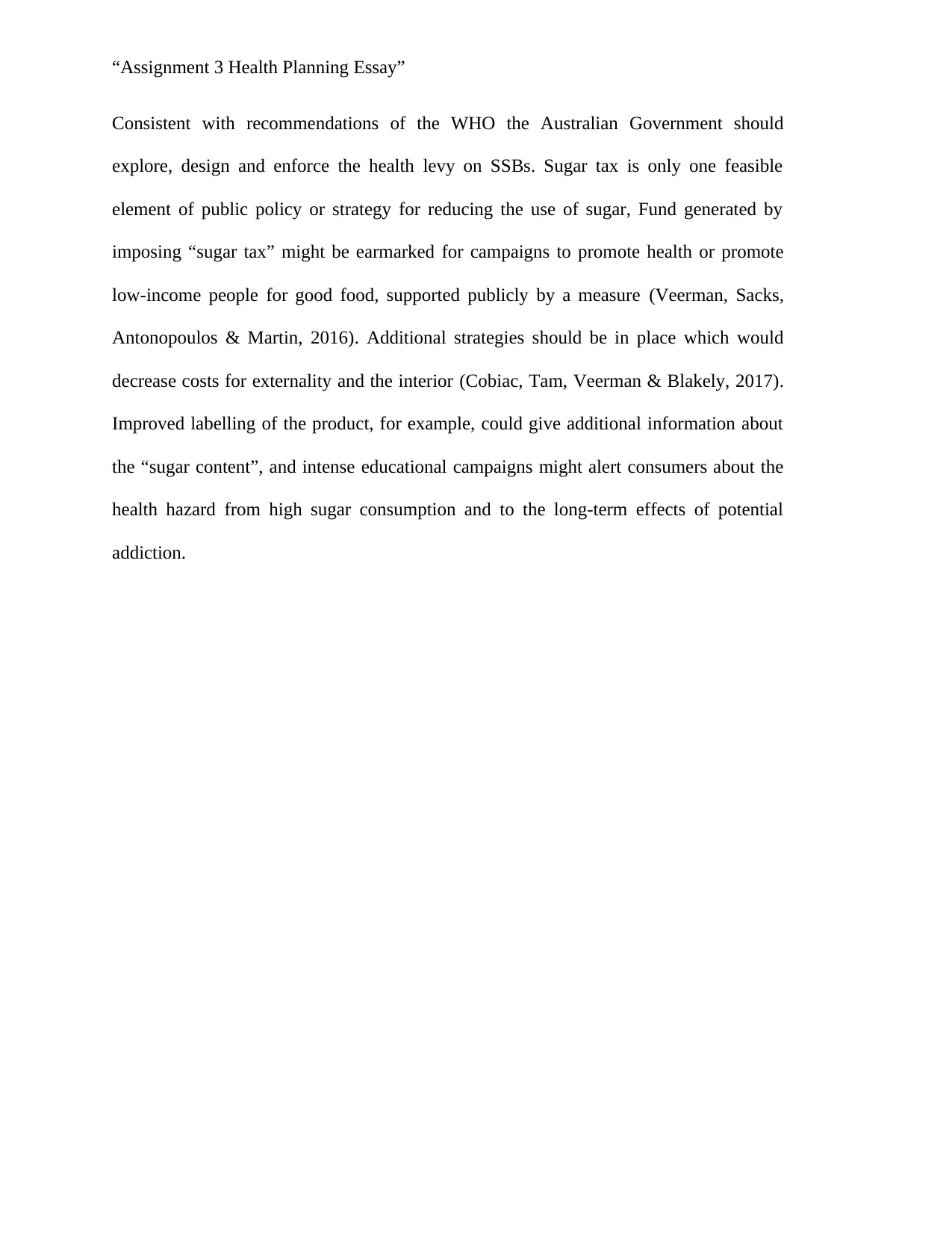
“Assignment 3 Health Planning Essay”
Consistent with recommendations of the WHO the Australian Government should
explore, design and enforce the health levy on SSBs. Sugar tax is only one feasible
element of public policy or strategy for reducing the use of sugar, Fund generated by
imposing “sugar tax” might be earmarked for campaigns to promote health or promote
low-income people for good food, supported publicly by a measure (Veerman, Sacks,
Antonopoulos & Martin, 2016). Additional strategies should be in place which would
decrease costs for externality and the interior (Cobiac, Tam, Veerman & Blakely, 2017).
Improved labelling of the product, for example, could give additional information about
the “sugar content”, and intense educational campaigns might alert consumers about the
health hazard from high sugar consumption and to the long-term effects of potential
addiction.
Consistent with recommendations of the WHO the Australian Government should
explore, design and enforce the health levy on SSBs. Sugar tax is only one feasible
element of public policy or strategy for reducing the use of sugar, Fund generated by
imposing “sugar tax” might be earmarked for campaigns to promote health or promote
low-income people for good food, supported publicly by a measure (Veerman, Sacks,
Antonopoulos & Martin, 2016). Additional strategies should be in place which would
decrease costs for externality and the interior (Cobiac, Tam, Veerman & Blakely, 2017).
Improved labelling of the product, for example, could give additional information about
the “sugar content”, and intense educational campaigns might alert consumers about the
health hazard from high sugar consumption and to the long-term effects of potential
addiction.
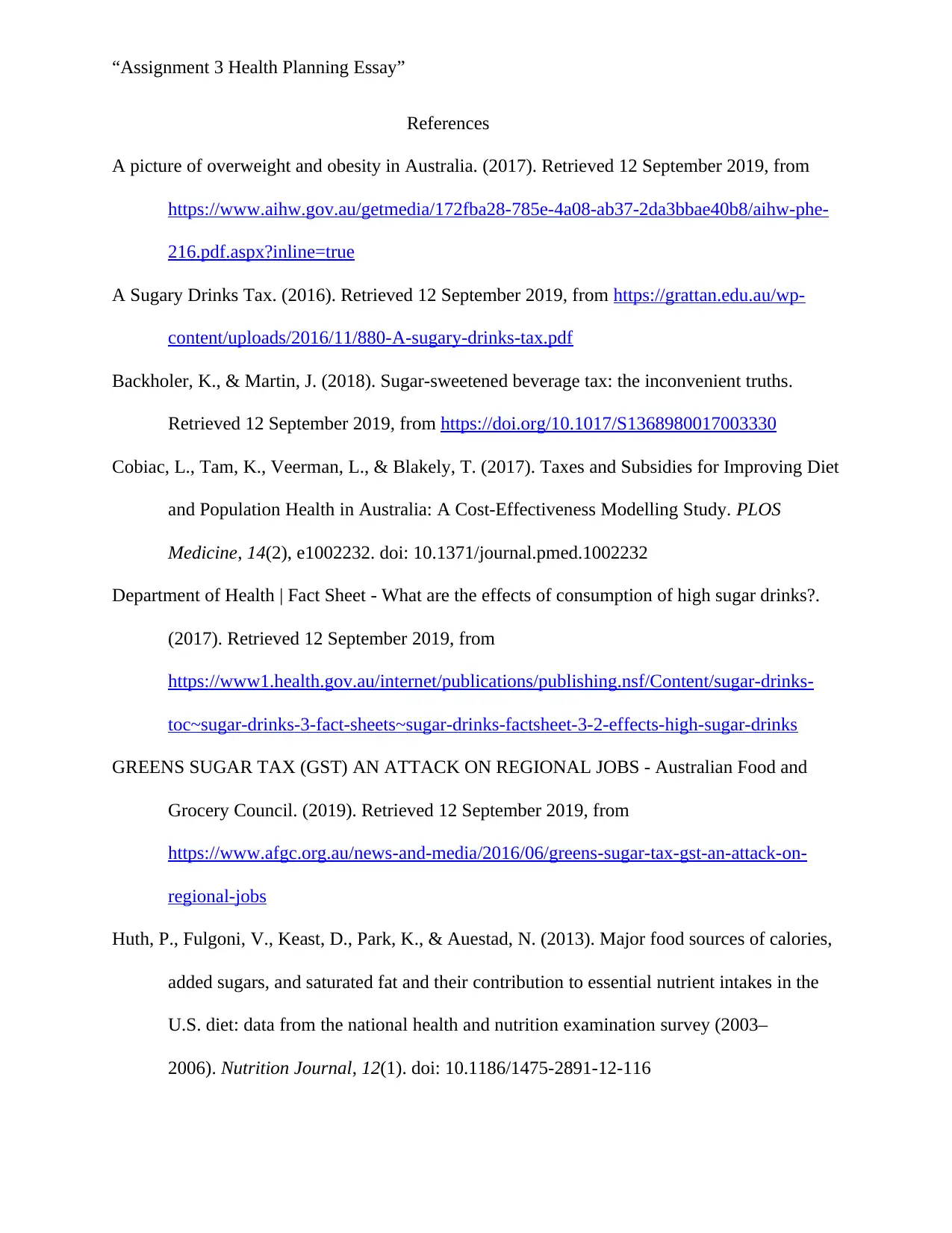
“Assignment 3 Health Planning Essay”
References
A picture of overweight and obesity in Australia. (2017). Retrieved 12 September 2019, from
https://www.aihw.gov.au/getmedia/172fba28-785e-4a08-ab37-2da3bbae40b8/aihw-phe-
216.pdf.aspx?inline=true
A Sugary Drinks Tax. (2016). Retrieved 12 September 2019, from https://grattan.edu.au/wp-
content/uploads/2016/11/880-A-sugary-drinks-tax.pdf
Backholer, K., & Martin, J. (2018). Sugar-sweetened beverage tax: the inconvenient truths.
Retrieved 12 September 2019, from https://doi.org/10.1017/S1368980017003330
Cobiac, L., Tam, K., Veerman, L., & Blakely, T. (2017). Taxes and Subsidies for Improving Diet
and Population Health in Australia: A Cost-Effectiveness Modelling Study. PLOS
Medicine, 14(2), e1002232. doi: 10.1371/journal.pmed.1002232
Department of Health | Fact Sheet - What are the effects of consumption of high sugar drinks?.
(2017). Retrieved 12 September 2019, from
https://www1.health.gov.au/internet/publications/publishing.nsf/Content/sugar-drinks-
toc~sugar-drinks-3-fact-sheets~sugar-drinks-factsheet-3-2-effects-high-sugar-drinks
GREENS SUGAR TAX (GST) AN ATTACK ON REGIONAL JOBS - Australian Food and
Grocery Council. (2019). Retrieved 12 September 2019, from
https://www.afgc.org.au/news-and-media/2016/06/greens-sugar-tax-gst-an-attack-on-
regional-jobs
Huth, P., Fulgoni, V., Keast, D., Park, K., & Auestad, N. (2013). Major food sources of calories,
added sugars, and saturated fat and their contribution to essential nutrient intakes in the
U.S. diet: data from the national health and nutrition examination survey (2003–
2006). Nutrition Journal, 12(1). doi: 10.1186/1475-2891-12-116
References
A picture of overweight and obesity in Australia. (2017). Retrieved 12 September 2019, from
https://www.aihw.gov.au/getmedia/172fba28-785e-4a08-ab37-2da3bbae40b8/aihw-phe-
216.pdf.aspx?inline=true
A Sugary Drinks Tax. (2016). Retrieved 12 September 2019, from https://grattan.edu.au/wp-
content/uploads/2016/11/880-A-sugary-drinks-tax.pdf
Backholer, K., & Martin, J. (2018). Sugar-sweetened beverage tax: the inconvenient truths.
Retrieved 12 September 2019, from https://doi.org/10.1017/S1368980017003330
Cobiac, L., Tam, K., Veerman, L., & Blakely, T. (2017). Taxes and Subsidies for Improving Diet
and Population Health in Australia: A Cost-Effectiveness Modelling Study. PLOS
Medicine, 14(2), e1002232. doi: 10.1371/journal.pmed.1002232
Department of Health | Fact Sheet - What are the effects of consumption of high sugar drinks?.
(2017). Retrieved 12 September 2019, from
https://www1.health.gov.au/internet/publications/publishing.nsf/Content/sugar-drinks-
toc~sugar-drinks-3-fact-sheets~sugar-drinks-factsheet-3-2-effects-high-sugar-drinks
GREENS SUGAR TAX (GST) AN ATTACK ON REGIONAL JOBS - Australian Food and
Grocery Council. (2019). Retrieved 12 September 2019, from
https://www.afgc.org.au/news-and-media/2016/06/greens-sugar-tax-gst-an-attack-on-
regional-jobs
Huth, P., Fulgoni, V., Keast, D., Park, K., & Auestad, N. (2013). Major food sources of calories,
added sugars, and saturated fat and their contribution to essential nutrient intakes in the
U.S. diet: data from the national health and nutrition examination survey (2003–
2006). Nutrition Journal, 12(1). doi: 10.1186/1475-2891-12-116
Secure Best Marks with AI Grader
Need help grading? Try our AI Grader for instant feedback on your assignments.
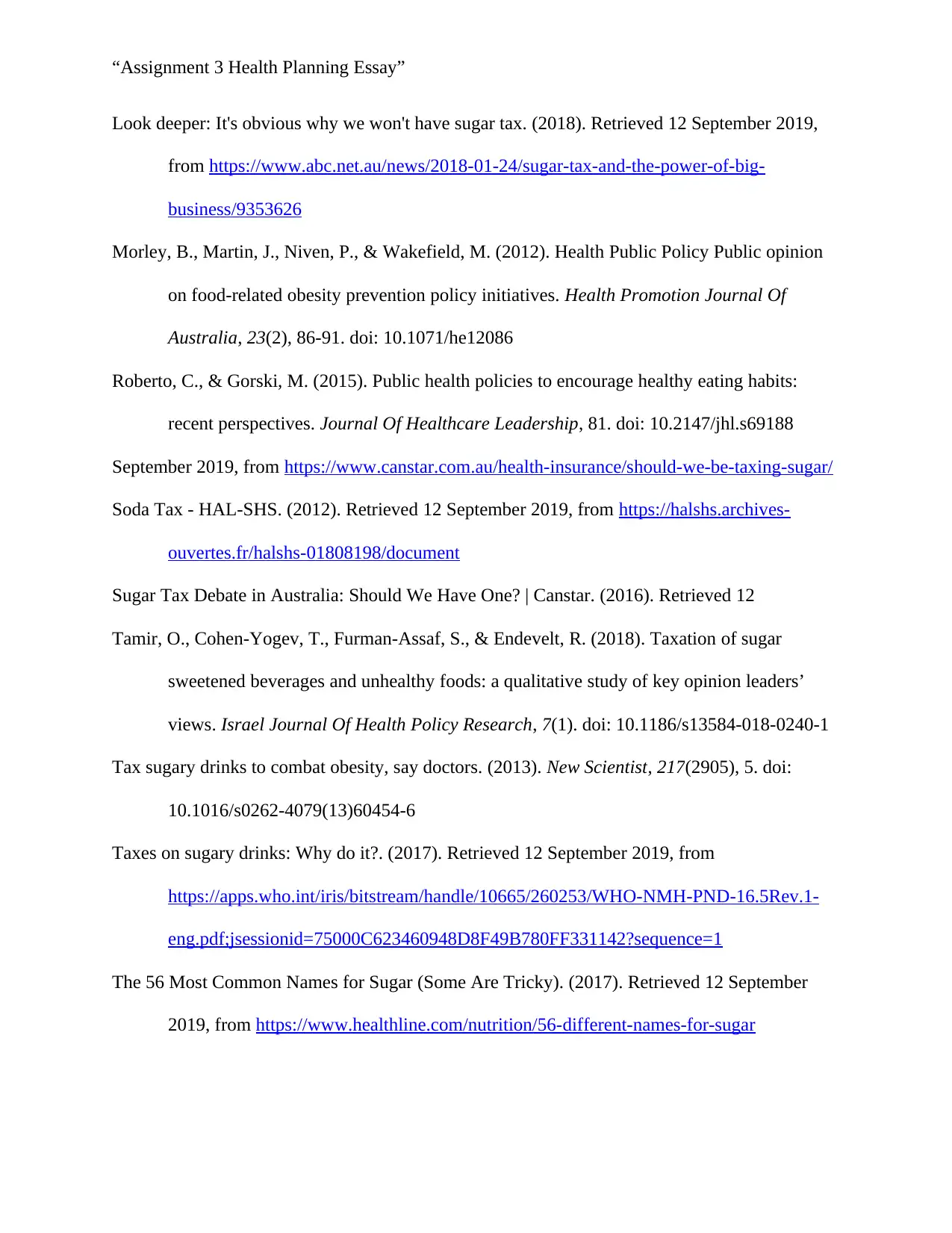
“Assignment 3 Health Planning Essay”
Look deeper: It's obvious why we won't have sugar tax. (2018). Retrieved 12 September 2019,
from https://www.abc.net.au/news/2018-01-24/sugar-tax-and-the-power-of-big-
business/9353626
Morley, B., Martin, J., Niven, P., & Wakefield, M. (2012). Health Public Policy Public opinion
on food-related obesity prevention policy initiatives. Health Promotion Journal Of
Australia, 23(2), 86-91. doi: 10.1071/he12086
Roberto, C., & Gorski, M. (2015). Public health policies to encourage healthy eating habits:
recent perspectives. Journal Of Healthcare Leadership, 81. doi: 10.2147/jhl.s69188
September 2019, from https://www.canstar.com.au/health-insurance/should-we-be-taxing-sugar/
Soda Tax - HAL-SHS. (2012). Retrieved 12 September 2019, from https://halshs.archives-
ouvertes.fr/halshs-01808198/document
Sugar Tax Debate in Australia: Should We Have One? | Canstar. (2016). Retrieved 12
Tamir, O., Cohen-Yogev, T., Furman-Assaf, S., & Endevelt, R. (2018). Taxation of sugar
sweetened beverages and unhealthy foods: a qualitative study of key opinion leaders’
views. Israel Journal Of Health Policy Research, 7(1). doi: 10.1186/s13584-018-0240-1
Tax sugary drinks to combat obesity, say doctors. (2013). New Scientist, 217(2905), 5. doi:
10.1016/s0262-4079(13)60454-6
Taxes on sugary drinks: Why do it?. (2017). Retrieved 12 September 2019, from
https://apps.who.int/iris/bitstream/handle/10665/260253/WHO-NMH-PND-16.5Rev.1-
eng.pdf;jsessionid=75000C623460948D8F49B780FF331142?sequence=1
The 56 Most Common Names for Sugar (Some Are Tricky). (2017). Retrieved 12 September
2019, from https://www.healthline.com/nutrition/56-different-names-for-sugar
Look deeper: It's obvious why we won't have sugar tax. (2018). Retrieved 12 September 2019,
from https://www.abc.net.au/news/2018-01-24/sugar-tax-and-the-power-of-big-
business/9353626
Morley, B., Martin, J., Niven, P., & Wakefield, M. (2012). Health Public Policy Public opinion
on food-related obesity prevention policy initiatives. Health Promotion Journal Of
Australia, 23(2), 86-91. doi: 10.1071/he12086
Roberto, C., & Gorski, M. (2015). Public health policies to encourage healthy eating habits:
recent perspectives. Journal Of Healthcare Leadership, 81. doi: 10.2147/jhl.s69188
September 2019, from https://www.canstar.com.au/health-insurance/should-we-be-taxing-sugar/
Soda Tax - HAL-SHS. (2012). Retrieved 12 September 2019, from https://halshs.archives-
ouvertes.fr/halshs-01808198/document
Sugar Tax Debate in Australia: Should We Have One? | Canstar. (2016). Retrieved 12
Tamir, O., Cohen-Yogev, T., Furman-Assaf, S., & Endevelt, R. (2018). Taxation of sugar
sweetened beverages and unhealthy foods: a qualitative study of key opinion leaders’
views. Israel Journal Of Health Policy Research, 7(1). doi: 10.1186/s13584-018-0240-1
Tax sugary drinks to combat obesity, say doctors. (2013). New Scientist, 217(2905), 5. doi:
10.1016/s0262-4079(13)60454-6
Taxes on sugary drinks: Why do it?. (2017). Retrieved 12 September 2019, from
https://apps.who.int/iris/bitstream/handle/10665/260253/WHO-NMH-PND-16.5Rev.1-
eng.pdf;jsessionid=75000C623460948D8F49B780FF331142?sequence=1
The 56 Most Common Names for Sugar (Some Are Tricky). (2017). Retrieved 12 September
2019, from https://www.healthline.com/nutrition/56-different-names-for-sugar
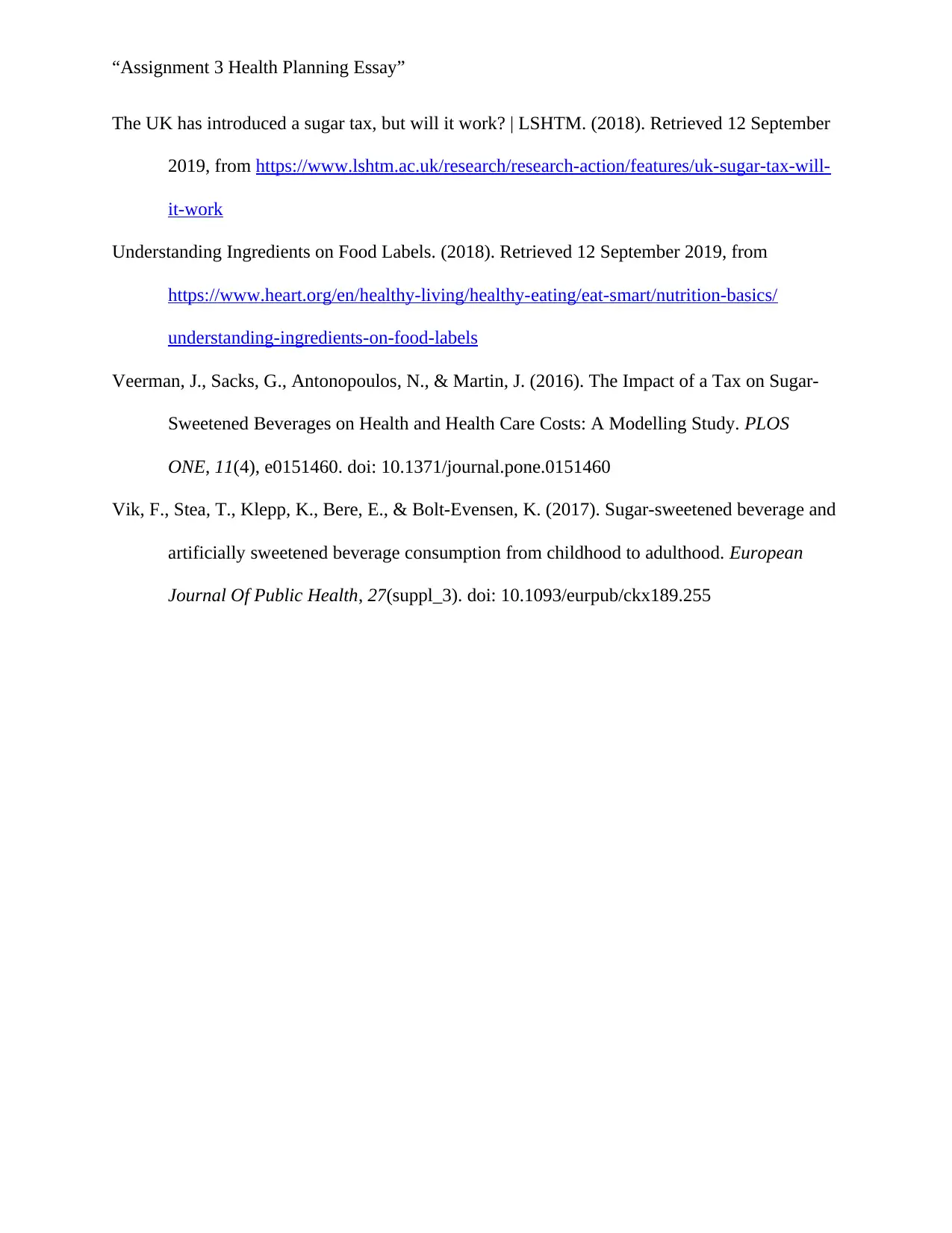
“Assignment 3 Health Planning Essay”
The UK has introduced a sugar tax, but will it work? | LSHTM. (2018). Retrieved 12 September
2019, from https://www.lshtm.ac.uk/research/research-action/features/uk-sugar-tax-will-
it-work
Understanding Ingredients on Food Labels. (2018). Retrieved 12 September 2019, from
https://www.heart.org/en/healthy-living/healthy-eating/eat-smart/nutrition-basics/
understanding-ingredients-on-food-labels
Veerman, J., Sacks, G., Antonopoulos, N., & Martin, J. (2016). The Impact of a Tax on Sugar-
Sweetened Beverages on Health and Health Care Costs: A Modelling Study. PLOS
ONE, 11(4), e0151460. doi: 10.1371/journal.pone.0151460
Vik, F., Stea, T., Klepp, K., Bere, E., & Bolt-Evensen, K. (2017). Sugar-sweetened beverage and
artificially sweetened beverage consumption from childhood to adulthood. European
Journal Of Public Health, 27(suppl_3). doi: 10.1093/eurpub/ckx189.255
The UK has introduced a sugar tax, but will it work? | LSHTM. (2018). Retrieved 12 September
2019, from https://www.lshtm.ac.uk/research/research-action/features/uk-sugar-tax-will-
it-work
Understanding Ingredients on Food Labels. (2018). Retrieved 12 September 2019, from
https://www.heart.org/en/healthy-living/healthy-eating/eat-smart/nutrition-basics/
understanding-ingredients-on-food-labels
Veerman, J., Sacks, G., Antonopoulos, N., & Martin, J. (2016). The Impact of a Tax on Sugar-
Sweetened Beverages on Health and Health Care Costs: A Modelling Study. PLOS
ONE, 11(4), e0151460. doi: 10.1371/journal.pone.0151460
Vik, F., Stea, T., Klepp, K., Bere, E., & Bolt-Evensen, K. (2017). Sugar-sweetened beverage and
artificially sweetened beverage consumption from childhood to adulthood. European
Journal Of Public Health, 27(suppl_3). doi: 10.1093/eurpub/ckx189.255
1 out of 12
Related Documents
Your All-in-One AI-Powered Toolkit for Academic Success.
+13062052269
info@desklib.com
Available 24*7 on WhatsApp / Email
![[object Object]](/_next/static/media/star-bottom.7253800d.svg)
Unlock your academic potential
© 2024 | Zucol Services PVT LTD | All rights reserved.





